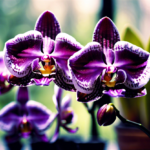Boston Fern (Nephrolepis exaltata) Overview
The Boston Fern, scientifically known as Nephrolepis exaltata, is a stunning and popular plant that belongs to the family Lomariopsidaceae. It is native to tropical regions of America and is highly valued for its lush, delicate fronds and air purifying qualities. With its feathery green foliage, the Boston Fern makes a wonderful addition to any indoor or outdoor space, bringing a touch of elegance and freshness.
One of the outstanding features of the Boston Fern is its arching, sword-like leaves that can grow up to 2-3 feet in length. The fronds are composed of multiple leaflets, giving them a layered appearance that adds dimension to the plant. The Boston Fern is a versatile plant that can thrive as a hanging basket, potted plant, or even as an outdoor border plant.
When it comes to care, the Boston Fern is relatively undemanding, making it an excellent choice for both experienced gardeners and beginners. However, providing the ideal growing conditions is crucial to ensure its health and vitality.
First and foremost, the Boston Fern prefers bright, indirect light. Placing it in a spot with a good amount of filtered light will ensure optimal growth. Avoid exposing it to direct sunlight, as this can scorch the delicate leaves. It is important to note that the Boston Fern can tolerate lower light conditions, but its growth may slow down.
In terms of temperature, the Boston Fern thrives in moderate to warm environments. Ideally, a temperature range of 60-75°F (15-24°C) is suitable for the plant. It is essential to keep the fern away from cold drafts or extreme temperature fluctuations, as they can cause stress and damage to the plant.
When it comes to watering, the Boston Fern requires consistent moisture. It appreciates a humid environment, so misting the foliage regularly or placing a tray filled with water nearby can help maintain the desired humidity level. However, it is crucial to avoid overwatering, as it can lead to root rot. Ensure that the soil is evenly moist but never waterlogged.
Fertilizing the Boston Fern is essential to promote healthy growth and vibrant foliage. During the growing season, which typically spans from spring to early fall, feeding the plant with a balanced, water-soluble fertilizer every two weeks can provide the necessary nutrients. However, it is important to dilute the fertilizer to half strength to avoid burning the delicate roots of the fern.
While the Boston Fern is generally a resilient plant, it can be susceptible to common pests and diseases. Mealybugs, aphids, and scale insects can occasionally infest the foliage. Regularly inspecting the plant and treating any infestations promptly with insecticidal soap or neem oil can help keep them at bay. Additionally, the Boston Fern can be prone to fungal diseases such as leaf spots and root rot, which can be prevented by ensuring adequate air circulation and avoiding overwatering.
The Boston Fern is a stunning and adaptable plant that can bring a touch of nature’s elegance to any space. By providing the ideal growing conditions, adequate watering, regular fertilization, and proactive pest management, you can ensure that your Boston Fern thrives and adds beauty to your home or garden for years to come.
Optimal Growing Conditions for Boston Ferns
Boston Ferns (Nephrolepis exaltata) are popular houseplants known for their delicate fronds and elegant appearance. To ensure the successful growth of these ferns, it is essential to provide them with the ideal growing conditions. Here are some tips to help you create the perfect environment for your Boston Ferns.
Firstly, Boston Ferns thrive in areas with bright but indirect light. They prefer a location that receives filtered sunlight, such as near a north or east-facing window. Avoid placing them in direct sunlight as it can scorch their delicate leaves. If you are growing your fern outdoors, make sure it is sheltered from intense sunlight.
In terms of temperature, Boston Ferns prefer a moderately warm environment. Ideally, the temperature should be kept between 60 to 75 degrees Fahrenheit (15 to 24 degrees Celsius). They are not frost-tolerant plants, so if you live in a colder climate, it’s best to grow them as indoor plants.
Humidity is crucial for the health and vitality of Boston Ferns. These plants are native to tropical and subtropical regions and thrive in high humidity environments. To maintain adequate moisture levels, you can use a humidifier or place a tray filled with water near the fern. Misting the leaves with water daily can also help increase humidity.
Proper watering is essential for Boston Ferns. These plants prefer consistently moist soil, but they don’t like to sit in standing water. Allow the top inch of the soil to dry out slightly before watering again. It’s important to water thoroughly until the water drains out of the bottom of the pot, ensuring that the roots receive adequate moisture.
When it comes to fertilizing Boston Ferns, a balanced liquid fertilizer can be applied once a month during the spring and summer months. However, it’s crucial not to over-fertilize, as excessive nutrients can lead to leaf burn. Always follow the instructions on the fertilizer package and dilute it to half the recommended strength.
While Boston Ferns are generally hardy plants, they can sometimes fall victim to pests and diseases. Common pests affecting these ferns include spider mites, aphids, and mealybugs. Regularly inspect the leaves for any signs of infestation and treat them promptly with insecticidal soap or neem oil.
Providing the optimal growing conditions for your Boston Ferns is key to their overall health and well-being. Remember to place them in an area with indirect light, maintain moderate temperatures, and provide sufficient humidity. Follow a regular watering and fertilizing routine, keeping an eye out for any potential pests or diseases. With proper care, your Boston Ferns will thrive and bring a touch of natural beauty to your indoor or outdoor space.
Boston Fern (Nephrolepis exaltata) Watering and Humidity Requirements
Proper watering and humidity are crucial for the health and vitality of Boston Ferns (Nephrolepis exaltata). These beautiful ferns thrive in environments that mimic their natural tropical habitat. Understanding their watering and humidity requirements is essential for their care.
When it comes to watering a Boston Fern, consistency is key. The soil should be kept consistently moist but not overly saturated. Overwatering can lead to root rot and other issues, while underwatering can cause the fern’s fronds to dry out and wither. To determine when to water, you can perform a simple test by pressing your finger into the soil. If it feels dry at a depth of about one inch, it’s time to water the fern.
To water a Boston Fern properly, use room temperature water and pour it directly onto the soil. Avoid wetting the fronds, as this can encourage fungal diseases. Water until you see it coming out of the drainage holes at the bottom of the pot. Afterward, make sure to empty the saucer to prevent the fern from sitting in standing water, which can lead to root rot.
Humidity is another crucial factor in Boston Fern care. These ferns thrive in humid environments. Ideally, the humidity levels should be between 40 and 60 percent. However, most indoor environments tend to be drier, especially during the winter months when heating systems are running.
To increase humidity around your Boston Fern, there are several strategies you can employ. One effective method is to place the fern on a tray filled with pebbles and water. As the water evaporates, it creates a humid microclimate around the plant. Another option is to use a humidifier or mist the fronds with water regularly. Additionally, grouping plants together can create a humid microclimate as they release moisture through transpiration.
It’s important to note that Boston Ferns are sensitive to dry air, so avoid placing them near air vents or drafts. If the air in your home is particularly dry, you may need to incorporate multiple humidity-increasing methods to meet the fern’s requirements.
By understanding and meeting the watering and humidity needs of your Boston Fern (Nephrolepis exaltata), you can ensure its lush and vibrant growth. Consistent watering and providing adequate humidity will help your fern thrive, creating a beautiful and eye-catching addition to your indoor or outdoor space.
Boston Fern (Nephrolepis exaltata) Care Guide: Tips for Fertilizing
Boston Ferns, scientifically known as Nephrolepis exaltata, are beautiful and popular houseplants that can thrive when provided with proper care. In addition to lighting, watering, and humidity requirements, fertilizing plays a crucial role in promoting the healthy growth of Boston Ferns. Here are some tips for effectively fertilizing your Boston Fern:
-
Choose the Right Fertilizer: When it comes to fertilizing Boston Ferns, it is important to select a balanced and diluted liquid fertilizer. Look for a fertilizer with an N-P-K (Nitrogen-Phosphorus-Potassium) ratio of around 10-10-10 or 20-20-20. This balanced ratio will ensure that your fern gets the essential nutrients it needs for healthy growth.
-
Frequency of Fertilizing: During the active growing season, which is typically spring and summer, Boston Ferns benefit from regular fertilization. You should fertilize your ferns every two weeks to supply them with a steady source of nutrients. However, during the winter months, when the ferns are in a dormant state, reduce the frequency to once a month or stop fertilizing altogether.
-
Dilute the Fertilizer: Boston Ferns have delicate roots, so it is important to dilute the fertilizer before applying it. Use a 1/4 to 1/2 strength dilution by mixing the recommended dosage with water. This will prevent any potential burn or damage to the fern’s delicate root system.
-
Apply Fertilizer Correctly: When applying fertilizer to your Boston Fern, make sure to pour it evenly around the plant’s roots. Avoid pouring the fertilizer directly onto the foliage, as this can cause burns. By watering the plant after fertilization, you will help distribute the nutrients to the root zone, enabling the fern to absorb them effectively.
-
Adjust Fertilizer During Repotting: When repotting your Boston Fern, it is an ideal time to refresh the soil and incorporate slow-release fertilizer pellets or granules into the potting mix. These slow-release fertilizers will provide a continuous source of nutrients to the fern over an extended period, reducing the need for frequent fertilization.
Remember, over-fertilizing can be harmful to Boston Ferns. If you notice any signs of fertilizer burn, such as yellowing or browning leaf tips, reduce the frequency or concentration of the fertilizer. Always follow the instructions provided by the manufacturer and adjust the fertilization routine based on the specific needs of your fern.
By providing your Boston Fern with the right amount of nutrients through fertilization, you will ensure its healthy growth and vibrant appearance. Incorporate these tips into your care routine, and your Boston Fern will thrive as a stunning addition to your indoor garden.
Common Pests and Diseases Affecting Boston Ferns
Boston Ferns (Nephrolepis exaltata) are popular houseplants known for their lush, feathery fronds. However, like any other plant, they are vulnerable to certain pests and diseases. Being aware of these common issues and knowing how to address them promptly can help ensure the health and vitality of your Boston Ferns.
Pests affecting Boston Ferns
One of the most common pests that can infest Boston Ferns is the scale insect. These tiny, sap-sucking insects attach themselves to the fronds, where they feed and reproduce. Scale insects can be identified as small, round or oval-shaped bumps that are usually brown or black. To get rid of scale insects, gently scrape them off the fronds using a soft brush or your fingernail. You can also use insecticidal soap or horticultural oil to control the infestation. Regularly inspecting your Boston Ferns for signs of scale insects is essential to catch the problem early.
Another common pest that may affect Boston Ferns is the mealybug. Mealybugs are small, white, cotton-like insects that cluster in the leaf axils and other hidden crevices of the plant. They feed on the plant’s sap, causing stunted growth and yellowing of the fronds. To remove mealybugs, wipe the affected areas with a cotton swab soaked in rubbing alcohol. Alternatively, you can use a neem oil solution to control the infestation. Regularly checking the undersides of the fronds and the plant’s hidden areas will help you detect and eliminate mealybugs before they cause significant damage.
Diseases affecting Boston Ferns
Root rot is a common disease that can affect Boston Ferns if they are overwatered or grown in poorly draining soil. This condition occurs when the roots of the plant are constantly saturated, leading to decay. To prevent root rot, ensure your Boston Ferns are planted in well-draining soil and water them only when the top inch of soil feels dry. If root rot is already present, you may need to replant the fern in fresh soil and trim away any affected roots. Proper watering practices and maintaining good airflow around the plant will help prevent root rot.
Another disease that can impact Boston Ferns is leaf spot. The symptoms of leaf spot include brown or black spots on the fronds, which can spread and cause the leaves to wither. Leaf spot is typically caused by fungal infections and thrives in humid environments. To prevent leaf spot, avoid overhead watering and provide adequate spacing between plants to promote air circulation. If leaf spot occurs, remove and destroy the affected fronds and treat the plant with a fungicidal spray.
being familiar with the common pests and diseases that can affect Boston Ferns is essential for their proper care. Regular monitoring, early detection, and prompt treatment will help keep these beautiful houseplants healthy and vibrant for years to come.
Conclusion
The Boston Fern (Nephrolepis exaltata) is a popular and beautiful fern that can be a stunning addition to any indoor or outdoor space. With its lush green fronds and graceful appearance, it brings a touch of nature and elegance to any setting.
To ensure the health and vitality of your Boston Fern, it is important to provide it with the ideal growing conditions. This includes placing it in a location with bright, indirect light, away from drafts or direct sunlight. The fern thrives in temperatures between 60-75°F (15-24°C), and high humidity. Additionally, maintaining proper air circulation around the plant can help prevent the onset of pests and diseases.
Watering and humidity requirements are crucial aspects of Boston Fern care. The fern prefers consistently moist soil, but not waterlogged. It is important to water the plant thoroughly, allowing excess water to drain away. However, it is equally important to avoid letting the soil dry out completely, as this can lead to wilting and dehydration. To meet the fern’s high humidity needs, misting the fronds regularly or placing the plant on a tray filled with pebbles and water can help maintain the necessary moisture levels.
Fertilizing the Boston Fern is another important aspect of proper care. During spring and summer, it is recommended to fertilize the plant every two weeks using a balanced liquid fertilizer. This will provide the necessary nutrients to support healthy growth. In the winter months, it is best to reduce or suspend fertilization, as the plant enters a period of dormancy.
Despite being relatively low-maintenance, Boston Ferns are still susceptible to common pests and diseases. Spider mites, mealybugs, and scale insects can infest the plant if proper care is not taken. Regularly inspect the fern for any signs of pests, and promptly treat them with appropriate insecticides or by manually removing them. Furthermore, certain diseases like leaf spot and root rot can occur due to overwatering or poor air circulation. To prevent these issues, ensure proper watering techniques and provide good airflow around the plant.
By following these care guidelines, you can enjoy the beauty and vibrancy of your Boston Fern for years to come. With the right growing conditions, watering and humidity routine, fertilization, and pest control, your fern is bound to flourish. So go ahead and bring a touch of nature indoors or enhance your outdoor space with the graceful presence of the Boston Fern.(453)


